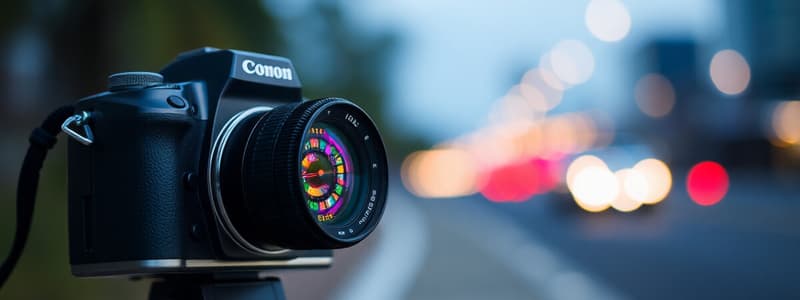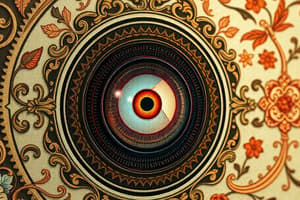Podcast
Questions and Answers
What does the term 'photography' literally mean?
What does the term 'photography' literally mean?
- Recording memories
- Drawing or writing with light (correct)
- Painting with shadows
- Capturing moments in time
Which of the following is a crucial component of photography?
Which of the following is a crucial component of photography?
- Sound
- Motion
- Smell
- Light (correct)
What does the aperture control in a camera?
What does the aperture control in a camera?
- The focus of the lens
- The amount of light passing through the lens (correct)
- The color balance of the image
- The duration of exposure to light
What is the purpose of the shutter in a camera?
What is the purpose of the shutter in a camera?
Which type of photography focuses on capturing natural scenery?
Which type of photography focuses on capturing natural scenery?
Which element of the exposure triangle controls the duration of exposure to light?
Which element of the exposure triangle controls the duration of exposure to light?
What does ISO measure in digital photography?
What does ISO measure in digital photography?
What is the result of using a wide aperture (low f-number)?
What is the result of using a wide aperture (low f-number)?
What is the unit of measurement for digital camera resolution?
What is the unit of measurement for digital camera resolution?
What is the primary function of image stabilization?
What is the primary function of image stabilization?
What is a lens with a fixed focal length called?
What is a lens with a fixed focal length called?
What type of lens is best for magnifying distant subjects?
What type of lens is best for magnifying distant subjects?
What kind of light reduces harsh shadows?
What kind of light reduces harsh shadows?
What does color temperature measure?
What does color temperature measure?
What photographic process corrects color casts to ensure accurate color rendition?
What photographic process corrects color casts to ensure accurate color rendition?
Which file format is a compressed format suitable for general use?
Which file format is a compressed format suitable for general use?
Which file format retains all image data and is uncompressed?
Which file format retains all image data and is uncompressed?
What is the purpose of post-processing in photography?
What is the purpose of post-processing in photography?
Which post-processing adjustment removes blemishes and imperfections?
Which post-processing adjustment removes blemishes and imperfections?
What post-processing technique is used to adjust the composition of an image?
What post-processing technique is used to adjust the composition of an image?
Flashcards
Photography
Photography
Creating durable images by recording light, either electronically via an image sensor or chemically via light-sensitive material.
Origin of 'Photography'
Origin of 'Photography'
Coined in 1839 from Greek words 'phos' (light) and 'graphé' (drawing/writing).
Camera
Camera
A device consisting of a lens, aperture, shutter, and image sensor or film, used to capture images.
Lens
Lens
Signup and view all the flashcards
Aperture
Aperture
Signup and view all the flashcards
Shutter
Shutter
Signup and view all the flashcards
Image Sensor/Film
Image Sensor/Film
Signup and view all the flashcards
Composition
Composition
Signup and view all the flashcards
Portrait Photography
Portrait Photography
Signup and view all the flashcards
Landscape Photography
Landscape Photography
Signup and view all the flashcards
Photojournalism
Photojournalism
Signup and view all the flashcards
Fashion Photography
Fashion Photography
Signup and view all the flashcards
Wildlife Photography
Wildlife Photography
Signup and view all the flashcards
Exposure Triangle
Exposure Triangle
Signup and view all the flashcards
Aperture
Aperture
Signup and view all the flashcards
Shutter Speed
Shutter Speed
Signup and view all the flashcards
ISO
ISO
Signup and view all the flashcards
Depth of Field
Depth of Field
Signup and view all the flashcards
Digital Cameras
Digital Cameras
Signup and view all the flashcards
Resolution
Resolution
Signup and view all the flashcards
Study Notes
- Photography is the art, application, and practice of creating durable images by recording light, either electronically by means of an image sensor, or chemically by means of a light-sensitive material such as photographic film
- It employs principles of light, optics, and chemistry to produce visual representations
Historical Overview
- The word "photography" was coined in 1839 from the Greek words φῶς (phos), meaning "light," and γραφή (graphé), meaning "drawing" or "writing"
- Early photography involved lengthy exposure times and cumbersome equipment
- The development of the daguerreotype and calotype processes marked significant milestones in the 19th century
- George Eastman's invention of flexible roll film and the Kodak camera in the late 1880s made photography accessible to the masses
Core Components
- The camera is the primary tool, consisting of a lens, aperture, shutter, and image sensor or film
- The lens focuses light onto the sensor or film
- The aperture controls the amount of light passing through the lens
- The shutter determines the duration of exposure to light
- The image sensor or film records the image
- Light is the fundamental element that makes photography possible
- Understanding the properties of light, such as intensity, color, and direction, is crucial
- Composition involves arranging visual elements within the frame to create an aesthetically pleasing image
- Key compositional techniques include the rule of thirds, leading lines, symmetry, and perspective
Types of Photography
- Portrait photography captures the likeness of individuals or groups
- Landscape photography focuses on capturing natural scenery
- Photojournalism documents newsworthy events and stories
- Fashion photography showcases clothing and accessories
- Wildlife photography captures animals in their natural habitats
- Street photography captures candid moments in public places
- Fine art photography is created as an artistic expression
- Macro photography captures extreme close-ups of small subjects
Exposure Triangle
- Aperture: Controls the amount of light entering the camera and affects depth of field
- Shutter Speed: Controls the duration of exposure to light and affects motion blur
- ISO: Measures the sensitivity of the image sensor to light
- Each element affects the brightness and clarity of an image
- Adjusting one setting often requires compensating with the others
- Depth of field refers to the range of distance within a scene that appears acceptably sharp in an image
- A wide aperture (low f-number) results in a shallow depth of field, blurring the background
- A narrow aperture (high f-number) results in a large depth of field, keeping both foreground and background sharp
Digital Photography
- Digital cameras use electronic image sensors to capture images
- Common sensor types include CCD (charge-coupled device) and CMOS (complementary metal-oxide-semiconductor)
- Resolution is measured in megapixels (MP), indicating the number of pixels in an image
- A higher megapixel count allows for larger prints and more detailed images
- Image stabilization reduces blur caused by camera shake
- Optical image stabilization (OIS) physically moves the lens or sensor to compensate for movement
- Digital image stabilization (DIS) uses software to reduce blur
Lenses
- Prime lenses have a fixed focal length, offering high image quality and wide apertures
- Zoom lenses have a variable focal length, providing flexibility in framing
- Wide-angle lenses have a short focal length, capturing a broad field of view
- Telephoto lenses have a long focal length, magnifying distant subjects
- Macro lenses are designed for close-up photography
Lighting Techniques
- Natural light harnesses sunlight to illuminate subjects
- Artificial light includes studio strobes, speedlights, and continuous lights
- Diffused light is soft and even, reducing harsh shadows
- Direct light is strong and creates distinct shadows
- Fill light is used to brighten shadows and reduce contrast
- Backlighting separates the subject from the background
Color in Photography
- Color temperature measures the warmth or coolness of light, measured in Kelvin (K)
- White balance corrects color casts to ensure accurate color rendition
- Color theory explores how colors interact and evoke emotions
- Saturation refers to the intensity of colors
- Contrast refers to the difference between light and dark areas in an image
File Formats
- JPEG is a compressed format suitable for general use
- RAW is an uncompressed format that retains all image data
- TIFF is a lossless format often used for archiving
- Understanding the characteristics of each file format ensures appropriate image storage and editing
Post-Processing
- Post-processing involves editing and enhancing images using software such as Adobe Photoshop, Lightroom, or Capture One
- Basic adjustments include exposure, contrast, white balance, and color correction
- Retouching removes blemishes and imperfections
- Cropping adjusts the composition of an image
- Sharpening enhances detail
Studying That Suits You
Use AI to generate personalized quizzes and flashcards to suit your learning preferences.




